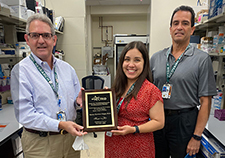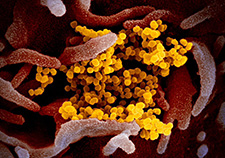Office of Research & Development |
 |
COVID-19 FACT SHEET |
In response to the COVID-19 pandemic, VA Research has undertaken a wide array of activities to support and advance VA's clinical and research missions and help Veterans affected by the disease. These efforts have spanned biomedical research, therapeutics and vaccine clinical trials, and data analyses that leverage VA's rich electronic health record system. VA Research has coordinated closely with internal VA and external partners—such as the National Institutes of Health and other federal agencies, and pharmaceutical companies—to identify the areas in which VA's nationwide research capacity, resources, and infrastructure could make the greatest contribution.
On this web page, we summarize recent and current COVID-19 research across the VA system.
Diabetes medication may lower COVID-19 heart and kidney risk
VA St. Louis researchers showed an SGLT2 inhibitor, a medication that lowers the amount of sugar in the blood, may also lower the risk of heart and kidney problems in people with COVID-19. The analysis included more than 100,000 Veterans taking diabetes medication who contracted COVID-19 between 2020 and 2023, over 11,000 of whom were taking an SGLT2 inhibitor. Those taking SGLT2 inhibitors had an 18% reduced risk of a major adverse cardiovascular event such as heart attack or stroke and a 25% reduced risk of a major adverse kidney event, compared to those taking other types of sugar-lowering medications. SGLT2 inhibitors were also linked to lower risk of secondary hospitalization outcomes, anemia, and acute kidney injury. The results suggest SGLT2 inhibitors may be useful to lower COVID-19 risks in people with diabetes. (Communications Medicine, Sept. 11, 2024)
COVID-19 increases Veterans’ risk of financial hardships
A VA study showed Veterans who contracted COVID-19 were at risk for health-related financial hardships 18 months after infection. Compared to uninfected Veterans, those with a history of COVID-19 were at four-times greater risk of severe-to-extreme health-related financial strain, three-times greater risk of taking less medication due to cost, and twice the risk of needing a loved one to take time off work to care for them. Veterans younger than 65 had a greater risk of financial hardship than older Veterans. The findings suggest a need for strategies to address financial problems caused by COVID-19. (BMC Health Services Research, Aug. 19, 2024)
Vaccines lower long COVID risk
VA St. Louis researchers demonstrated vaccination substantially lowered the risk of long COVID. The study included VA medical records of nearly 450,000 Veterans who had COVID-19 between 2020 and 2022, along with 4.7 million Veterans who were not infected during that time. In the COVID group, 3.5% of those who were vaccinated developed long COVID symptoms one year after infection, compared to 7.8% of unvaccinated Veterans. The study also showed the risk of long COVID has declined since the beginning of the pandemic, with the researchers attributing three-quarters of the decline to the availability of vaccines and the remaining quarter to changes in virus strains. (New England Journal of Medicine, Jul. 17, 2024)
Arthritis drug decreases delirium, coma in critically ill COVID-19 patients
A study including a VA Tennessee Valley researcher found the arthritis drug tocilizumab can decrease delirium and coma in critically ill patients with COVID-19. The study included 253 patients with COVID-19 being treated in the ICU, 69 of whom received tocilizumab. The tocilizumab group had a greater number of days without delirium or coma. The drug did not affect mortality, ventilator use, or hospital length of stay. The results indicate tocilizumab could be an effective way to address delirium and comas in severely ill COVID-19 patients. (Scientific Reports, May 23, 2024)
Blood pressure control in Veterans declined during COVID-19 pandemic
A multi-institution team led by researchers at the White River Junction VA Medical Center in Vermont found that, in a group of nearly 1.65 million Veterans, 7% had a decline in blood pressure control during the COVID-19 pandemic. Most of the difference was explained by delays in follow-up care in Veterans whose blood pressure had been under control before the pandemic. Conversely, those who had uncontrolled high blood pressure before the pandemic were slightly more likely to gain control during the pandemic, suggesting providers focused more on people with uncontrolled blood pressure during this time. (Medical Care, Mar. 1, 2024)
Clinical Trials
Time to sustained recovery among outpatients with COVID-19 receiving montelukast vs placebo: The ACTIV-6 randomized clinical trial . Rothman RL, Stewart TG, Mourad A, Boulware DR, McCarthy MW, Thicklin F et al. Treatment with montelukast did not reduce duration of COVID-19 symptoms. Findings do not support the use of montelukast for the treatment of mild to moderate COVID-19. JAMA Netw Open. 2024 Oct 1;7(10):e2439332.
Acute estradiol and progesterone therapy in hospitalized adults to reduce COVID-19 severity: A randomized control trial . Lovre D, Qadir MM, Bateman K, Saltzman LY, Sherman M, Mauvais-Jarvis F. Short-term estradiol and progesterone treatment in patients hospitalized for COVID-19 decreased biomarkers of inflammation. Sci Rep. 2024 Sep 30;14(1):22732.
Favorable antiviral effect of metformin on SARS-CoV-2 viral load in a randomized, placebo-controlled clinical trial of COVID-19 . Bramante CT, Beckman KB, Mehta T, Karger AB, Odde DJ, Tignanelli CJ, Buse JB et al. Metformin significantly reduced SARS-CoV-2 viral load, which may explain the clinical benefits in this trial. Clin Infect Dis. 2024 Aug 16;79(2):354-363.
Favorable antiviral effect of metformin on severe acute respiratory syndrome coronavirus 2 viral load in a randomized, placebo-controlled clinical trial of coronavirus disease 2019 . Bramante CT, Beckman KB, Mehta T, Karger AB, Odde DJ, Tignanelli CJ, Buse JB et al. Metformin reduced SARS-CoV-2 viral load 3.6-fold compared to placebo. Clin Infect Dis. 2024 May 1. Online ahead of print.
High-dose fluvoxamine and time to sustained recovery in outpatients with COVID-19: The ACTIV-6 randomized clinical trial . Stewart TG, Rebolledo PA, Mourad A, Lindsell CJ, Boulware DR, McCarthy MW et al. Among outpatients with mild to moderate COVID-19, treatment with fluvoxamine does not reduce duration of COVID-19 symptoms. JAMA. 2023 Nov 17. Online ahead of print.
Laboratory Studies
Long COVID elevated MMP-9 and release from microglia by SARS-CoV-2 spike protein . Kempuraj D, Tsilioni I, Aenlle KK, Klimas NG, Theoharides TC. Release of the enzyme MMP-9 from the COVID-19 virus spike protein stimulated by microglia immune cells could contribute to the development of long COVID and may serve as a target for treatment. Transl Neurosci. 2024 Oct 13;15(1)20220352.
Extacellular histones: A unifying mechanism driving platelet-dependent extracellular vesicle release and thrombus formation in COVID-19 . Eustes AS, Ahmed A, Swamy J, Patil G, Jensen M, Wilson KM, Kudchadkar S et al. Extracellular proteins called histones and procoagulant extracellular vesicles drive the prothrombotic state in COVD-19, and histone-targeted therapy may prove beneficial. J Thromb Haemost. 2024 Sep;22(9):2514-2530.
Differentiation of prior SARS-CoV-2 infection and postacute sequelae by standard clinical laboratory measurements in the RECOVER cohort . Erlandson KM, Geng LN, Selvaggi CA, Thaweethai T, Chen P Erdmann NB et al. No evidence was found that any of 25 routine clinical laboratory tests could serve as a clinically useful biomarker for post-acute sequelae of COVID-19. Ann Intern Med. 2024 Sep;177(9):1209-1221.
Evidence from whole genome sequencing of aerosol transmission of SARS-CoV-2 almost 5 hours after hospital turnover . Charness ME, Gupta K, Linsenmeyer K, Strymish J, Madjarov R, Stack G. Airborne SARS-CoV-2 virus may transmit infection for over four hours, even in a hospital setting. Am J Infect Control. 2024 Jul;52(7):849-851.
Intranasal neomycin evokes broad-spectrum antiviral immunity in the upper respiratory tract . Mao T, Kim J, Peña-Hernández MA, Valle G, Moriyama M, Luyten S, Ott IM et al. Prophylactic or therapeutic administration of neomycin provided significant protection against upper respiratory infection in a model of COVID-19. In healthy humans, intranasal application of neomycin-containing Neosporin ointment induced an effective gene response that could protect from COVID-19. Proc Natl Acad Sci U S A. 2024 Apr 30;121(18):e2319566121.
Data Analysis/Review
Effects of buprenorphine, methadone, and substance-use on COVID-19 morbidity and mortality . Christian NJ, Zhou X, Radhakrishnan R. Active substance use was associated with increased morbidity in COVID-19 infection. Medication for opioid use disorder was not associated with worse COVID-19 outcomes compared to other opioids. J Addict Med. 2024 Oct 30. Online ahead of print.
Identifying Veterans who benefit from nirmatrelvir-ritonavir: A target trial emulation . Yan L, Bui D, Li Y, Rajeevan N, Rowneki M, Berry Argraves S et al. Nirmatrelvir-ritonavir was effective in reducing 30-day hospitalization and death in older Veterans, those at highest predicted risk for severe outcomes, and immunocompromised groups. Benefit was not observed in younger Veterans or groups at lower predicted risk for hospitalization and death. 2024 Sep 26;79(3):643-651.
Prevalence and risk factors of post-acute sequelae of SARS-CoV-2 (PASC) among Veterans in airborne hazards and open burn pit registry: A prospective, observational, nested study . Phen SM, Jani N, Klein-Adams JC, Ndirangu DS, Rahman A, Falvo MJ. Post-acute sequelae of COVID-19 are common among Veterans enrolled in the Airborne Hazards and Open Burn Pit Registry, but researchers did not observe any unique military risk factors that augmented the risk. BMC Infect Dis. 2024 Aug 21;24(1):846.
Postoperative outcomes associated with the timing of surgery after SARS-CoV-2 infection . Leeds IL, Park LS, Akgun K, Weintrob A, Justice AC, King JT Jr. In a contemporary surgical cohort, patients with prior COVID-19 infection only had increased postoperative mortality or complications when they had surgery within 14 days after the positive test. Ann Surg. 2024 Aug 1;280(2):241-247
Patients taking benralizumab, dupilumab, or mepolizumab have lower postvaccination SARS-CoV-2 immunity . Runnstrom MC, Lamothe PA, Faliti CE, Cheedarla N, Moreno A, Suthar MS, Nahata R et al. Patients taking biologic medications for asthma or dermatitis had weaker immune responses to COVID-19 vaccination. J Allergy Clin Immunol. 2024 Aug;154(2):435-446.
Other Research
Development and validation of a machine learning COVID-19 Veteran (COVet) deterioration risk score . Govindan S, Spicer A, Bearce M, Schaefer RS, Uhl A, Alterovitz G, Kim MJ et al. Researchers used machine learning methods to develop and validate a highly accurate early warning score in both Veterans and non-Veterans hospitalized with COVID-19. The model could lead to earlier identification and therapy, which may improve outcomes. Crit Care Explor. 2024 Jul 19;6(7):e1116.
Self-reported impacts of the COVID-19 pandemic and economic inflation on the well-being of low-income U.S. Veterans . Tsai J, Hird R, Collier A. Low-income Veterans reported resilience in response to the COVID-19 pandemic and inflation. J Community Health. 2023 Dec;48(6):970-974.
Prevalence and associations of poor mental health in the third year of COVDI-19: U.S. population-based analysis from 2020 to 2022 . Kim J, Linos E, Rodriguez CI, Chen ML, Dove MS, Keegan TH. Mental health of U.S. adults worsened in the third year of COVID-19 compared to the beginning of the pandemic. Psychiatry Res. 2023 Dec:330:115622.
Using multi-modal electronic health record data for the development and validation of risk prediction models for Long COVID using the Super Learner algorithm . Jin W, Hao W, Shi X, Fritsche LG, Salvatore M, Admon AJ, Friese CR, Mukherjee B. Researchers created a composite risk score for post-acute sequelae of COVID prediction, which could contribute to the identification of individuals at higher risk for Long COVID and inform preventive efforts. J Clin Med. 2023 Nov 25;12(23):7313.
Modifying Whole Health services for successful telehealth delivery: Lessons from Veterans Health Administration’s rapid transition during the COVID-19 pandemic . Wu J, Bolton R, Anwar C, Bokhour BG, Khanna A, Mullur RS, Taylor SL, Hyde J. The COVID-19 pandemic catalyzed tele-Whole Health service implementation, utilization, and sustainment. The challenges faced and modifications made during this transition provide lessons learned for other health care systems as they attempt to implement telehealth services. J Integr Complement Med. 2023 Sep 1. Online ahead of print.
Commentary
Long COVID science, research and policy . Al-Aly Z, Davis H, McCorkell L, Soares L, Wulf-Hanson S, Iwasaki A, Topol EJ. The writers provide a synthesis of the state of scientific evidence on long COVID; assess the impacts of long COVID on human health, health systems, the economy, and global health metrics; and provide a forward-looking research and policy roadmap. Nat Med. 2024 Aug 9. Online ahead of print.
Long Covid and impaired cognition – More evidence and more work to do . Al Aly Z, Rosen CJ. A deeper understanding of the biology of cognitive dysfunction after COVID-19 and how best to prevent and treat it are critical for addressing the needs of affected persons and preserving the cognitive health of the population. N Engl J Med. 2024;390:858-860.
Solving the puzzle of Long Covid . Al-Aly Z, Topol E. Studying Long COVID can lead to a deeper understanding of infection-associated chronic illnesses and optimize preparedness for future pandemics. Science. 2024 Feb 22;383(6685):830-832.
Long COVID-19 and suicide . Sher L. It is vital to educate clinicians that patients with long COIVD may be suicidal and that it is essential to screen patients with long COVID for suicidality. Adv Exp Med Biol. 2024;1458:51-57.
Global vaccine inequality threatens to unleash the next COVID-19 variant. Oehler RL, Vega VR. The emergence of COVID-19 variants from under-vaccinated regions is a direct consequence of the virus replicating unchecked through an unprotected population. Much more needs to be done to address global vaccine inequities and prevent the next devastating variant. Int J Infect Dis. 2022 Aug 18. Online ahead of print.
As of November 2021, nearly 70 VA medical centers are involved in one or more COVID-19 clinical trials. Below are several examples. A full list of COVID-19 Clinical Trials in VA is also available.

VA center training the next generation of researchers in blood clots and inflammation

NIAID provides COVID-19 antiviral drug for VA’s Veteran patients

VA research spells out COVID's down-the-road risks for cardiovascular and mental health